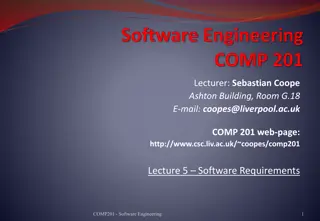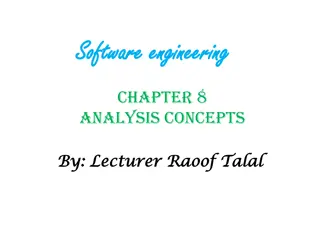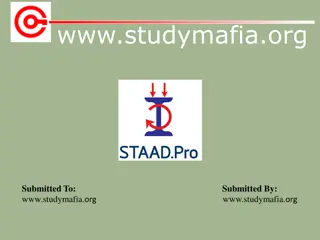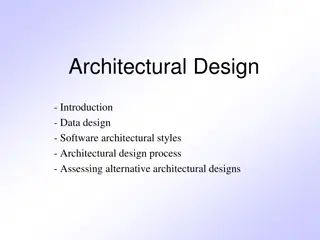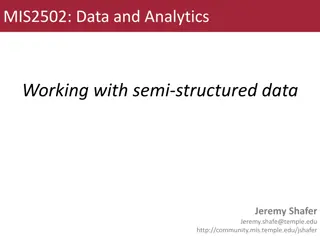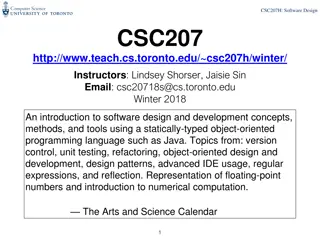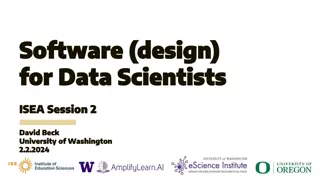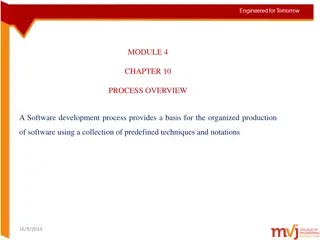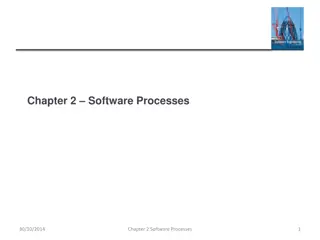Understanding Structured Analysis in Software Design
Structured analysis in software design aims to describe customer requirements, create a basis for software design, and define validatable requirements. Two main modeling philosophies, structured analysis, and object-oriented analysis are discussed. Structured Analysis Model Elements such as Data Flow Diagrams (DFD), Entity Relationship Diagrams (ERD), and State Diagrams are key components. Flow-oriented modeling illustrates how data is transformed within the system. Creating Data Flow Models is essential for developing a comprehensive understanding of the system.
Download Presentation

Please find below an Image/Link to download the presentation.
The content on the website is provided AS IS for your information and personal use only. It may not be sold, licensed, or shared on other websites without obtaining consent from the author. Download presentation by click this link. If you encounter any issues during the download, it is possible that the publisher has removed the file from their server.
E N D
Presentation Transcript
Chapter 3 Structured Analysis Software Analysis and Design 0721322 1
Introduction The analysis model must achieve three primary objectives : 1. to describe what the customer requires system description 2. to establish a basis for the creation of a software design analysis model 3. to define a set of requirements that can be validated once the software is built. The analysis model bridges the gap between system-level description that describes overall system functionality and system design. design model 2
Introduction Two different modeling philosophies can be applied: - Structured analysis : Considers data and the process that transform the data as separate entities. Views software as an information transformer. Assists the software engineer in identifying data objects, their relationships, and the manner in which those data objects are transformed. - Object-oriented analysis : Focuses on the definition of classes and the manner in which they collaborate with one another to affect customer requirements. 3
Structured Analysis Model Elements Data flow diagram (DFD) - provides an indication of how data are transformed as they move through the system; also depicts functions that transform the data flow. Entity relationship diagram (ERD) - depicts relationships between data objects Data dictionary - contains the descriptions of all data objects consumed or produced by the software State diagram (SD) - indicates how the system behaves as a consequence of external events, states are used to represent behavior modes. Arcs are labeled with the events triggering the transitions from one state to another (control information is contained in control specification or CSPEC) 4
Flow-oriented modeling Flow-oriented modeling shows how data are transformed inside the system by processing functions. Creating a Data Flow Model : The Data-flow models are used to show how data objects flow through a sequence of processing steps. Creating a Control Flow Model : Represents events and the processes that manage events. 5
Creating a Data flow Model The data flow diagram enables the software engineer to develop models of the information domain and functional domain. Data-flow modeling is a core modeling activity in structured analysis. DFDs model the system from a functional perspective Tracking and documenting how the data associated with a process is helpful to develop an overall understanding of the system Data flow diagrams may also be used in showing the data exchange between a system and other systems in its environment. DFD's cannot show procedural detail (e.g., conditionals or loops) only the flow of data through the software 6
Levelled DFDs Terminator 1 Terminator 2 Break each process down into sub- processes Numbering of processes indicates their parents process, and thus their position in the hierarchy of levelled DFDs0 The System Datastore 1 Terminator 3 Context Diagram Terminator 2 1. Wiggle Widget Terminator 1 2. Grind Gadget 3. Dangle Doover Terminator 3 Datastore 1 Figure 0 DFD 8
Levelled DFDs A data flow diagram (DFD) of the scope of an organizational system that shows the system boundaries, external entities that interact with the system and the major information flows between the entities and the system - Indicate the people, organisations and systems which communicate with our system - Show the data which our system receives from the outside world - Show the data produced by the system and sent to the outside world - Show the data which is shared by the system with the outside world - Show the boundary between the system and the rest of the world Level-O Diagram A data flow diagram (DFD) that represents a system s major processes, data flows and data stores at a high level of detail Context Diagram 9
Process Specifications Data flow diagrams do not show the logic inside the processes Logic modeling involves representing internal structure and functionality of processes depicted on a DFD All bottom level processes are specified The specifications may be o Structured English o Pre/Post Conditions o Decision Tables Need to be more formal and specific than normal English Need to be easily understandable by the user Should not impose arbitrary design or implementationdecisions 12
Process Specifications and DFDs Figure 2 DFD CONTEXT DIAGRAM Note: 2.2 Process 2.3 is a lowest-level process 2.1 Note: Observe that Figures 0 and 2 are balanced w.r.t. incoming and outgoing dataflows 2.3 Process Spec for Level 2.3 kahgdkljhckldsajcaljscaljljakdclnh kljclkjcl;kjcl;asjca;sjcjc;kkdj;jsa;k ckjal;kjcalkjcal;jcaljcal;kjckljcakj if kjc = mjclakj then do ldclscknlskld else jhalkscjl lnhclsncdslnc end - specification 1 2 Process Specification for Process 2.3 3 4 Figure 0 DFD 13
Structured English Subset of English with restrictions on usage Each sentence must be as follows: an algebraic equation e.g. X = (Y*(Z+2))/Q+14 or consist of a simple imperative sentence with a verb and an object e.g. READ next Order e.g. DISPLAY Result to Screen Can use IF THEN ELSE construction Can use CASE construction can use LOOP construction Object must be defined in the analysis (i.e. in Data Dictionary) or must be a local term defined for that process only 14
An example Calculate Tax Rate - Process Specification in Structured English IFgoods are Taxable DO CASE CASEgoods-type = Food SET tax-rate to 0 CASEgoods-type = Vehicle SET tax-rate to 20 CASE goods-type = Clothes SET tax-rate to 40 OTHERWISE SET tax-rate to 15 ENDCASE ELSE WRITE Tax not applicable to Results data store 15 ENDIF
An example Process 1.0: Update Inventory Added Do READ next Invoice-item-record FIND matching Inventory-record ADD Quantity-added from Invoice-item-record to Quantity-in- stock on inventory-record UNTIL End-of-file Process 2.0: Update Inventory Used Do READ next Stock-item-record FIND matching Inventory-record SUBTRACT Quantity-used on Stock-item-record from Quantity- in-stock on inventory-record UNTIL End-of-file 16
Pre and Post Conditions Describe the process without specifying the algorithm Useful approach when need to get away from existing method of performing the task there may be many possible algorithms to use want to let the implementer explore the values of various algorithms 17
Pre Conditions Describe what must be true before the process begins operating: What inputs must be available e.g. Account Number exists What relationships exist between inputs or within inputs e.g. Purchase Order account number is the same as the Customer account number What relationships exist between inputs and data stores e.g. There is a Customer with that account number in the Customer data store What relationships exists between different stores or within a single store e.g. there is a purchase order in the Purchase Order data store with the current date 18
Post Conditions Describe what must be true when the process is completed: The outputs that will be generated by the process e.g. An invoice will be generated The relationship between the output and the original input values e.g. invoice-total will equal the sum of the unit prices multiplied by number ordered plus shipping-costs Relationships between output values and values in one or more stores e.g. The number-remaining for each item in the Inventory data store will be reduced by the amount- ordered for each item The changes that will have been made to stores e.g. A new record will be appended to the Invoice data store 19
Modeling Logic with Decision Tables A matrix representation of the logic of a decision Used when the process result is based around several different variables and the logic gets too complex for other methods Specifies the possible conditions and the resulting actions Best used for complicated decision logic Consists of three parts Conditions Lists condition relevant to decision Actions Actions that result from a given set of conditions Rules Specify which actions are to be followed for a given set of conditions 20
Example 1 Y Y N N N 2 Y N Y N N X 3 Y N N Y N 4 Y N N N Y 5 N Y N N N 6 N N Y N N 7 N N N Y N 8 N N N N Y Goods are taxable Goods type = Clothes Goods type = Food Goods type = Vehicles Goods type = Other Set tax rate = 0 Set tax rate = 20 Set tax rate = 40 Set tax rate = 15 Write tax not applicable X X X X X X X 22
Entity-Relationship Diagrams Model the relationships between data in the system Highlight the relationships between data stores directly When using ERD for data modeling, only relationships that are represented in the data stores (e.g. via a foreign key) should be shown Very useful in relational database systems Often more central to your system than DFDs 4 Components Entity types Relationships Associative entity types Supertype/subtype indicators 23
Entity Types A collection of entities whose individual members have the following characteristics: Each can be uniquely identified in some manner Each plays a necessary role in the system we are building Each can be described by one or more data elements CHARACTERISTICS Has a Customer Number Is necessary for a sales system Described by elements such as name, address, customer number, phone, number, credit rating etc. Customer 24
Relationships has CAPITAL COUNTRY One to One Relationship purchases ITEM CUSTOMER One to Many Relationship SUPPLIER supplies COMPANY Many to Many Relationship 25
Associative Entities Sometimes it is necessary to store data about a relationship We then need to turn the relationship into an entity CUSTOMER ITEM purchases We might want to keep track of date of purchase, method of purchase, location of purchase, none of which fit into the Customer or Item entity So we create a Purchase entity Note that Customer and Item exist regardless of any Purchase Purchase only exists as a result of the relationship between the other two Customer Item Purchase 26
Supertypes/Subtypes Often there are different types of a basic entity For example if we have a CUSTOMER entity, but we keep different information on customers using cash and customers using credit we could specify it as follows: Customer Credit Customer Cash Customer 27
E-R Diagram Guidelines If all data elements in an entity don t apply to all instances, think about creating subtypes Carefully examine to see if associative entities are needed Modify the diagram when: Consist only of an identifier and have no data elements Have only one instance in the system Can derive the information and thus the relationship is unnecessary Remember that ER-Diagrams are for modelling data stored in the system There is no need to show external entities about which no data is stored 28
Data dictionaries Data dictionaries are lists of all of the names used in the system models. Descriptions of the entities, relationships and attributes are also included Advantages Support name management and avoid duplication Store of organisational knowledge linking analysis, design and implementation 30
Data Dictionary Contents Name - primary name for each data or control item, data store, or external entity Alias - alternate names for each data object Where-used/how-used - a listing of processes that use the data or control item and how it is used (e.g., input to process, output from process, as a store, as an external entity) Content description - notation for representing content Supplementary information - other data type information, preset values, restrictions, limitations, etc. 31
Data Dictionary Notation = is composed of + and ( ) optional ( may be present or absent) { } iteration [ ] select one of several alternatives ** comment @ identifier (key field) for a datastore | separates alternative choices in the [ ] construct 32
Data Dictionary examples order = @order-id + customer-name + shipping-address + 1{item}10 orders = {order} customer-name = courtesy-title + first-name + (middle-name)+ last-name courtesy-title = [Mr. | Miss | Mrs. | Ms. | Dr. | Professor] first-name = {legal-character} middle-name = {legal-character} last-name = {legal-character} legal-character = [A-Z|a-z|0-9| |-| |] an order always has an order-id (which is the key field), a customer-name and a shipping-address, and has between 1 and 10 items. 33
State-Transition Diagrams State-Transition Diagrams (STD) model time-dependent behavior. Many complex systems have time-dependent behaviour, that is, the sequence in which data will be accessed and functions will be performed Have 4 components States : A state is usually denoted either with a rectangle or an oval. The state is labeled with a noun. Transitions : A transition is denoted by an arrow line connecting one state to another, with the arrow indicating the transition direction. The transition is labeled with a condition, and optionally a corresponding action. A condition is usually a noun phrase, while an action is most often a verb phrase. Conditions : A condition is an event in the external environment which triggers a transition to a new state Actions : An action is a response sent back to the external environment or a calculation whose result is stored by the system that occurs when the transition takes place Can be levelled like DFDs Must have one initial state and may have multiple final states 34
Answering Machine Example: states and transitions Idle Waiting for call Recording Message Playing Messages Rewinding Note: this STD is incomplete: conditions and actions are not shown Answering Call 35
Example of conditions/actions Condition Condition Idle Press Cancel button Press Answer button Ready to receive light goes on Ready to receive button goes out Waiting for Call Action Action End of Call or tape runs out Incoming call detected Answering Call Condition Condition 36
Microwave oven model Full power Full power do: set power = 600 Timer Waiting do: display time Number Operation Set time do: get number exit: set time Full power do: operate oven Half power Half power Door closed Cancel Timer Door open Start Door open Waiting do: display time Half power do: set power = 300 Enabled do: display 'Ready' Door closed Disabled do: display 'Waiting' 37
Microwave oven state description State Description Waiting Half power The oven is waiting for input. The display shows the current time. The oven power is set to 300 watts. The display shows Half power . The oven power is set to 600 watts. The display shows Full power . The cooking time is set to the user s input value. The display shows the cooking time selected and is updated as the time is set. Oven operation is disabled for safety. Interior oven light is on. Display shows Not ready . Oven operation is enabled. Interior oven light is off. Display shows Ready to cook . Oven in operation. Interior oven light is on. Display shows the timer countdown. On completion of cooking, the buzzer is sounded for 5 seconds. Oven light is on. Display shows Cooking complete while buzzer is sounding. Full power Set time Disabled Enabled Operation 38
Integrating the Models Structured Analysis consists of many different models Each model focuses on one aspect of the system Often hard to see the connections between the different models, resulting in inconsistencies Need an approach to check each model against the other models 39
Structured analysis and structured design (SASD) may be approached in the following manner: Environmental modeling: defines the boundary between the system and the rest of the world (external objects) and consists of three different activities: context diagram event list Functional/Behavioral modeling: The functional and behavioral model describes the required behavior of the insides of the system necessary to interact successfully with the environment data flow diagram process specification data dictionary entity relationship diagram state transition diagram Implementation Modeling : The implementation model comprises the design portion of SASD structure charts considerations for modules structured design 42
DFDs and the Data Dictionary Every data flow (arrow on a DFD) and every data store must be defined in the data dictionary Every data element and every data store must appear on a data flow diagram somewhere in the system Every data store in the DFDs must correspond to an entity type or a relationship or an associative entity Entity names and data store names must match. Use plural for data stores, singular for entities. 43
E-R Diagram and DFDs CUSTOMERS = CUSTOMER = name + address + phone-number + ... {Customer} Data dictionary entities must apply to both the DFD model and the E-R model Every Control bubble in a DFD must have an associated state-transition diagram as its process specification Every condition in the state-transition diagram must correspond to an incoming control flow on the control bubble Every action in the state-transition diagram must correspond to an outgoing control flow on the control bubble 44

 undefined
undefined






